The NVIDIA GeForce GTX 980 Review: Maxwell Mark 2
by Ryan Smith on September 18, 2014 10:30 PM ESTPower, Temperature, & Noise
As always, last but not least is our look at power, temperature, and noise. Next to price and performance of course, these are some of the most important aspects of a GPU, due in large part to the impact of noise. All things considered, a loud card is undesirable unless there’s a sufficiently good reason – or sufficiently good performance – to ignore the noise.
Having already seen the Maxwell architecture in action with the GTX 750 series, the GTX 980 and its GM204 Maxwell 2 GPU have a very well regarded reputation to live up to. GTX 750 Ti shattered old energy efficiency marks, and we expect much the same of GTX 980. After all, NVIDIA tells us that they can deliver more performance than the GTX 780 Ti for less power than the GTX 680, and that will be no easy feat.
| GeForce GTX 980 Voltages | ||||
| GTX 980 Boost Voltage | GTX 980 Base Voltage | GTX 980 Idle Voltage | ||
| 1.225v | 1.075v | 0.856v | ||
We’ll start as always with voltages, which in this case I think makes for one of the more interesting aspects of GTX 980. Despite the fact that GM204 is a pretty large GPU at 398mm2 and is clocked at over 1.2GHz, NVIDIA is still promoting a TDP of just 165W. One way to curb power consumption is to build a processor wide-and-slow, and these voltage numbers are solid proof that NVIDIA has not done that.
With a load voltage of 1.225v, NVIDIA is driving GM204 as hard (if not harder) than any of the Kepler GPUs. This means that all of NVIDIA’s power optimizations – the key to driving 5.2 billion transistors at under 165W – lie with other architectural optimizations the company has made. Because at over 1.2v, they certainly aren’t deriving any advantages from operating at low voltages.
Next up, let’s take a look at average clockspeeds. As we alluded to earlier, NVIDIA has maintained the familiar 80C default temperature limit for GTX 980 that we saw on all other high-end GPU Boost 2.0 enabled cards. Furthermore as a result of reinvesting most of their efficiency gains into acoustics, what we are going to see is that GTX 980 still throttles. The question then is by how much.
| GeForce GTX 980 Average Clockspeeds | |||
| Max Boost Clock | 1252MHz | ||
| Metro: LL |
1192MHz
|
||
| CoH2 |
1177MHz
|
||
| Bioshock |
1201MHz
|
||
| Battlefield 4 |
1227MHz
|
||
| Crysis 3 |
1227MHz
|
||
| TW: Rome 2 |
1161MHz
|
||
| Thief |
1190MHz
|
||
| GRID 2 |
1151MHz
|
||
| Furmark |
923MHz
|
||
What we find is that while our GTX 980 has an official boost clock of 1216MHz, our sustained benchmarks are often not able to maintain clockspeeds at or above that level. Of our games only Bioshock Infinite, Crysis 3, and Battlefield 4 maintain an average clockspeed over 1200MHz, with everything else falling to between 1151MHz and 1192MHz. This still ends up being above NVIDIA’s base clockspeed of 1126MHz – by nearly 100MHz at times – but it’s clear that unlike our 700 series cards NVIDIA is much more aggressively rating their boost clock. The GTX 980’s performance is still spectacular even if it doesn’t get to run over 1.2GHz all of the time, but I would argue that the boost clock metric is less useful this time around if it’s going to overestimate clockspeeds rather than underestimate. (ed: always underpromise and overdeliver)
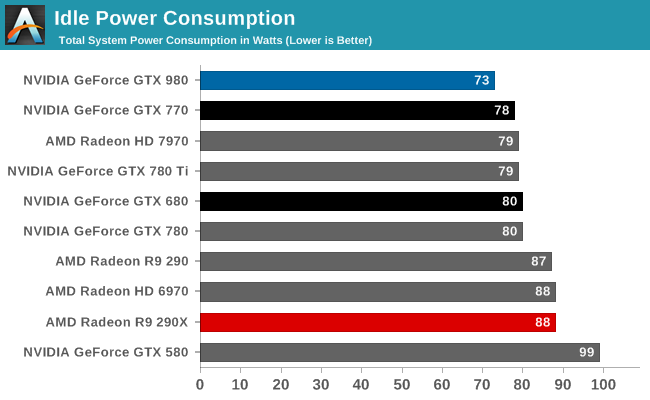
Starting as always with idle power consumption, while NVIDIA is not quoting specific power numbers it’s clear that the company’s energy efficiency efforts have been invested in idle power consumption as well as load power consumption. At 73W idle at the wall, our testbed equipped with the GTX 980 draws several watts less than any other high-end card, including the GK104 based GTX 770 and even AMD’s cards. In desktops this isn’t going to make much of a difference, but in laptops with always-on dGPUs this would be helpful in freeing up battery life.

Our first load power test is our gaming test, with Crysis 3. Because we measure from the wall, this test means we’re seeing GPU power consumption as well as CPU power consumption, which means high performance cards will drive up the system power consumption numbers merely by giving the CPU more work to do. This is exactly what happens in the case of the GTX 980; at 304W it’s between the GK104 based GTX 680 and GTX 770, however it’s also delivering 30% better framerates. Accordingly the power consumption of the GTX 980 itself should be lower than either card, but we would not see it in a system power measurement.
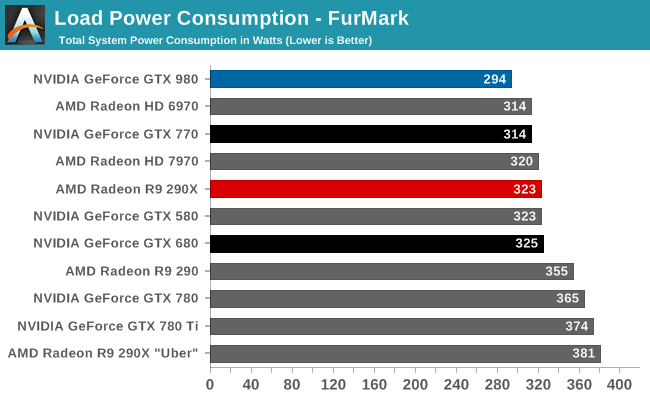
For that reason, when looking at recent generation cards implementing GPU Boost 2.0 or PowerTune 3, we prefer to turn to FurMark as it essentially nullifies the power consumption impact of the CPU. In this case we can clearly see what NVIDIA is promising: GTX 980’s power consumption is lower than everything else on the board, and noticeably so. With 294W at the wall, it’s 20W less than GTX 770, 29W less than 290X, and some 80W less than the previous NVIDIA flagship, GTX 780 Ti. At these power levels NVIDIA is essentially drawing the power of a midrange class card, but with chart-topping performance.
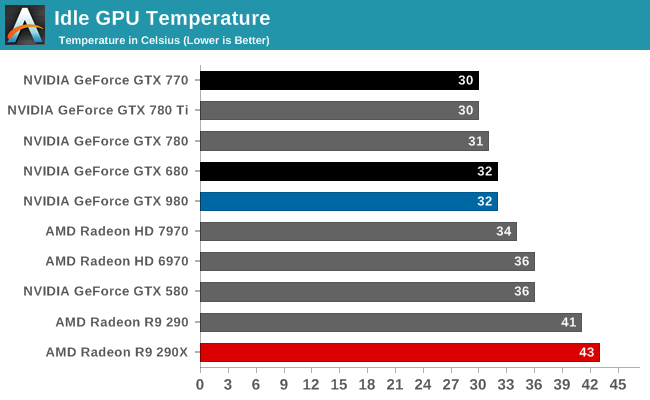
Moving on to temperatures, at idle we see nothing remarkable. All of these well-designed, low idle power designs are going to idle in the low 30s, especially since they’re not more than a few degrees over room temperature.

With an 80C throttle point in place for the GTX 980, it’s here where we see the card top out at. The fact that we’re hitting 80C is the reason why the card is exhibiting clockspeed throttling as we saw earlier. NVIDIA’s chosen fan curve is tuned for noise over temperature, so it’s letting the GPU reach its temperature throttle point rather than ramp up the fan (and the noise) too much.
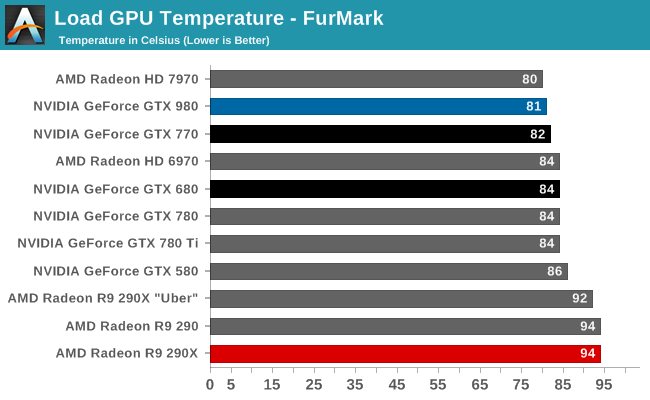
Once again we see the 80C throttle in action. Like all GPU Boost 2.0 NVIDIA cards, NVIDIA makes sure their products aren’t going to get well over 80C no matter the workload.
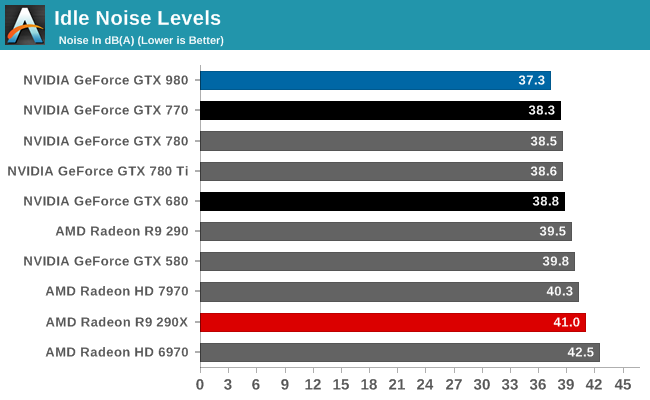
Last but not least we have our noise results. Right off the bat the GTX 980 is looking strong; even with the shared heritage of the cooler with the GTX 780 series, the GTX 980 is slightly but measurably quieter at idle than any other high-end NVIDIA or AMD card. At 37.3dB, the GTX 980 comes very close to being silent compared to the rest of the system.

Our Crysis 3 load noise testing showcases the full benefits of the GTX 980’s well-built blower in action. GTX 980 doesn’t perform appreciably better than the GTX Titan cooler equipped GTX 770 and GTX 780, but then again GTX 980 is also not using quite as advanced of a cooler (forgoing the vapor chamber). Still, this is enough to edge ahead of the GTX 770 by 0.1dB, technically making it the quietest video card in this roundup. Though for all practical purposes, it’s better to consider it tied with the GTX 770.

FurMark noise testing on the other hand drives a wedge between the GTX 980 and all other cards, and it’s in the GTX 980’s favor. Despite the similar noise performance between various NVIDIA cards under Crysis 3, under our maximum, pathological workload of FurMark the GTX 980 pulls ahead thanks to its 165W TDP. At the end of the day its lower TDP limit means that the GTX 980 never has too much heat to dissipate, and as a result it never gets too loud. In fact it can’t. 48.1dB is as loud as the GTX 980 can get, which is why the GTX 980’s cooler and overall build are so impressive. There are open air cooled cards that now underperform the GTX 980 that can’t hit these low of noise levels, never mind the other cards with blowers.
Between the GTX Titan and its derivatives and now GTX 980, NVIDIA has spent quite a bit of time and effort on building a better blower, and with their latest effort it really shows. All things considered we prefer blower type coolers for their heat exhaustion benefits – just install it and go, there’s almost no need to worry about what the chassis cooling can do – and with NVIDIA’s efforts to build such a solid cooler for a moderately powered card, the end result is a card with a cooler that offers all the benefits of a blower with the acoustics that can rival and open air cooler. It’s a really good design and one of our favorite aspects of GTX Titan, its derivatives, and now GTX 980.










274 Comments
View All Comments
garadante - Thursday, September 25, 2014 - link
Yeah. To be honest nobody except ardent Nvidia fanboys would've believed Nvidia would release cards as performance and price competitive as they did, especially the 970. The 980 is honestly a little overpriced compared to a few generations ago as they'll slap a $200 premium on it for Big Maxwell but $330 MSRP for the 970 (if I remember correctly) wasn't bad at all, for generally what, 290/780/290X performance?tuxRoller - Friday, September 26, 2014 - link
It's not too surprising as we saw what the 750ti was like.What is disappointing, though, is that I thought nvidia had made some fundamental breakthrough in their designs where, instead, it looks as though they "simply" enabled a better governor.
garadante - Friday, September 26, 2014 - link
It'll be interesting to see how the efficiency suffers once nvidia releases a proper compute die with area dedicated to double precision FP. I have to keep in mind that when factoring in the stripped down die compared to AMD's 290/290X cards, the results aren't as competition. Lowing as they first seem. But if AMD can't counter these cards with their own stripped down gaming only cards then nvidia took the win this generation.tuxRoller - Friday, September 26, 2014 - link
That's an excellent point. I take it you already read the tomshardware review? They're compute performance/W is still good, but not so unbelievable as their gaming performance, but I'm not sure it's b/c this is a gaming only card. Regardless, though, amd needs to offer something better than what's currently available. Unfortunately, I don't think they will be able to do it. There was a lot of driver work than went into making these maxwell cards humgaradante - Friday, September 26, 2014 - link
One thing that really bothers me though is how Anandtech keeps testing the 290/290X with reference cards. Those cards run at 95 C due to the fan control profile in the BIOS and I remember seeing that when people ran those cards with decent nonreference cooling in the 70 C range that power consumption was 15-20+ watts lower. So an AMD die that sacrifices FP64 performance to focus on FP32(gaming, some compute) performance as well as decreasing die size due to the lack of FP64 resources seems like it could be a lot more competitive with Maxwell than people are making it out to be. I have this feeling that the people saying how badly Maxwell trounces AMD's efficiency and that AMD can't possibly hope to catch up are too biased in their thinking.tuxRoller - Saturday, September 27, 2014 - link
Do you have a link to those reviews that show non-reference fans make gpus more efficient? I don't know how that could be possible. Given the temps we're looking at the effects on the conductors should be very, very small.Regarding the reduction in fp performance and gaming efficiency, that's a good point. That may indeed be part of the reason why nvidia has the gaming/compute split (aside from the prices they can charge).
garadante - Sunday, September 28, 2014 - link
Here's an example of a card with liquid cooling. Factor in the overclock that the nonreference card has and that it draws something like 20 watts less in Furmark and the same in 3Dmark. I could be mistaken on the improved power usage but I do recall seeing shortly after the 290X launch that nonreference coolers helped immensely, and power usage dropped as well. Sadly I don't believe Anandtech ever reviewed a nonreference 290X... which is mind boggling to consider, considering how much nonreference cooling helped that card, even outside of any potential power usage decreases.garadante - Sunday, September 28, 2014 - link
http://www.tomshardware.com/reviews/lcs-axr9-290x-... Whoops, forgot the link.jman9295 - Friday, September 26, 2014 - link
I wonder why they still give these cards these boring numbered names like GTX 980. Except for the Titan, these names kinda suck. Why not at least name it the Maxwell 980 or for AMD's R( 290 series the Hawaii 290. That sounds a lot cooler than GTX or R9. Also, for the last several generations, AMD and Nvidia's numbering system seems to be similar up until AMD ended that with the R9/R7 200 series. Before that, they had the GTX 700 and HD 7000 series, the GTX 600 and HD 6000 series and so on. Then, as soon as AMD changed it up, Nvidia decides to skip the GTX 800's for retail desktop GPUs and jump right up to the 900 series. Maybe they will come up with a fancier name for their next gen cards besides the GTX 1000's.AnnonymousCoward - Saturday, September 27, 2014 - link
Naw, names are much harder to keep track of than numbers that inherently describe relative performance.